
On the night of Oct 13/14, 2020, under poor conditions, I acquired images of the star KK Cnc , as well as data on Ross 248 and GX And.
My measurements suggest that KK Cnc has entered the superhump phase, but clouds ruined all but a short stretch of measurements.
You can find some basic information on this star at the SIMBAD page.
The main setup was:
Notes from the night:
The object is at
RA = 08:07:14.25 Dec = +11:38:12.5 (J2000)
A chart of the field is shown below. The size of the chart is about 16 x 16 arcminutes.

I've marked the location of several comparison stars.
star ID B V ------------------------------------------------------------------------- A APASS 53280329 11.356 10.028 C APASS 53295398 13.350 12.827 (mags from AAVSO) --------------------------------------------------------------------------
I used star "C" to shift the instrumental magnitudes to the V-band scale, following the values given for this star in the AAVSO chart X25677BDK.
I took a photo of the finder TV's screen when pointing to KK Cnc; this could be a useful reference for the future:
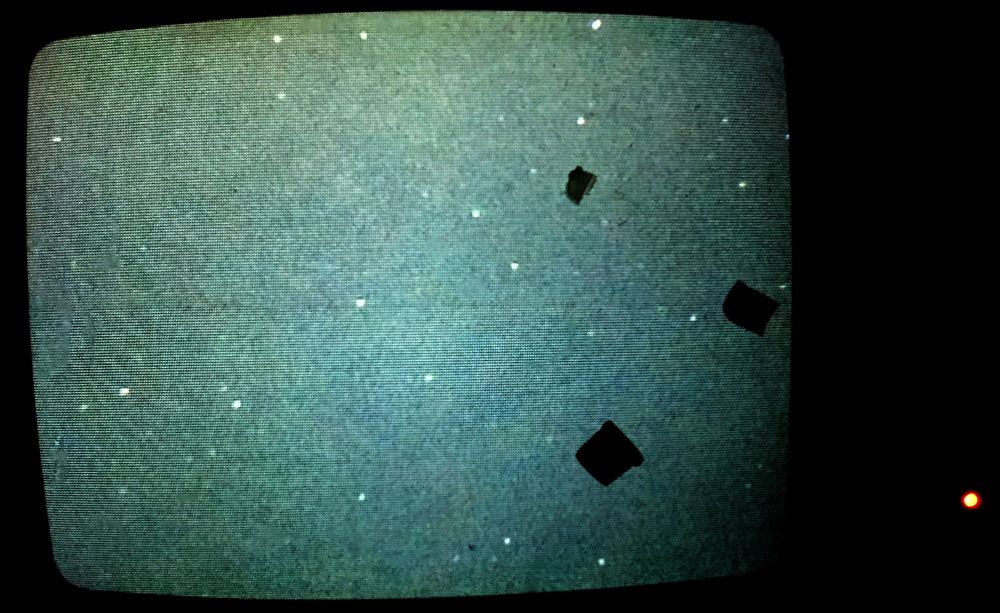
I ran the camera at the normal temperature of -20 C. Nothing out of the ordinary. Note that the dark values for 20 and 40 seconds are nearly identical.

I took a series of 179 exposures of the field, using no filter and an exposure time of 40 seconds. Some images were slightly trailed, but I think the gain in signal was worth it.
The sky value shows that thick clouds were present more than half the time :-(
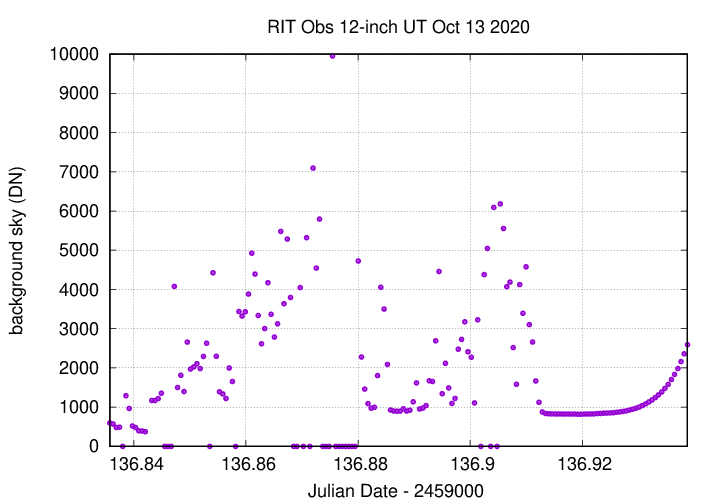
The number of objects detected.
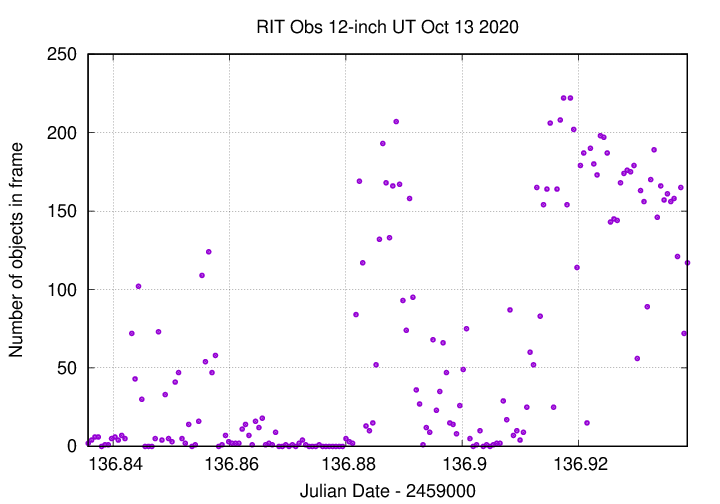
I used an aperture with radius 5.0 pixels tonight, as the FWHM was around 4 pixels in the KK Cnc images.

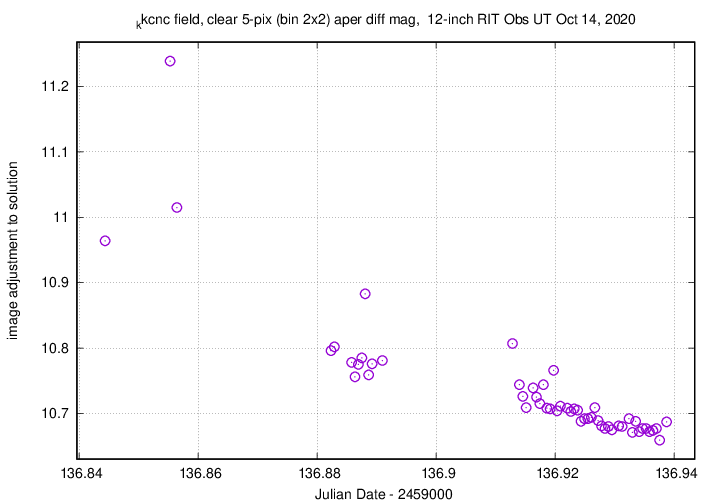
Using aperture photometry with a radius of 5 pixels (binned 2x2, each pixel is 1.25 arcsec, so a radius of 6.25 arcsec), I measured the instrumental magnitudes of a number of reference stars and the target. Following the procedures outlined by Kent Honeycutt's article on inhomogeneous ensemble photometry, I used all stars available in each image to define a reference frame, and measured each star against this frame.
Sigma-vs-mag plots show that the floor was about 0.005 mag overall. KK Cnc is the outlier at around instrumental mag 2.9. It has grown considerably more variable since UT Oct 10.

Here are light curves of the variable and the field stars.
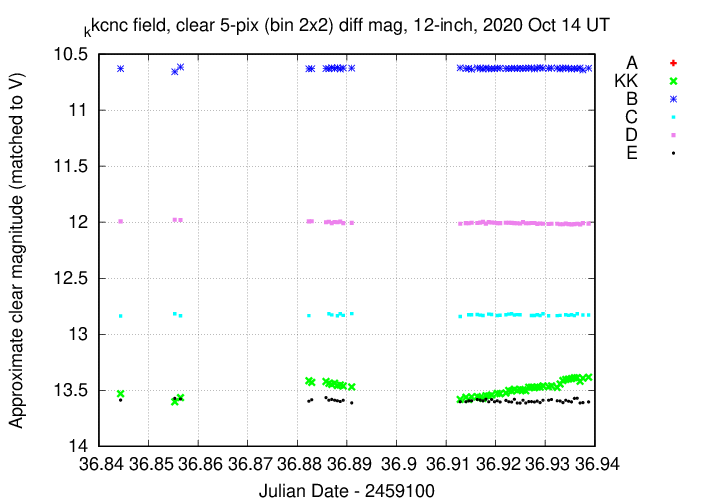
I used the AAVSO value for the V-band magnitude of star "B" = APASS 53295398 to shift the ensemble UNFILTERED magnitudes to the standard V-band scale.
Here's a closeup on the variable. It shows a sharp increase by 0.2 mag at the end of the run, which I am guessing is a signal of superhumps.
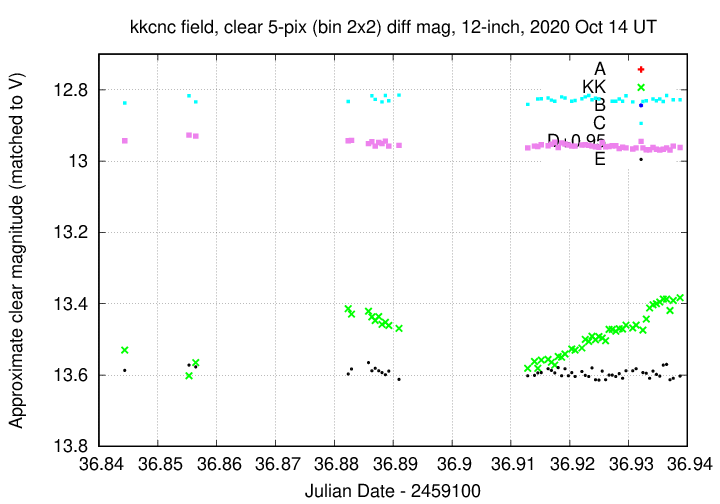
You can download my measurements below. A copy of the header of the file is shown to explain the format.
# Measurements of KKCnc made at RIT Obs, UT 2020 Oct 14, # in poor conditions, # by Michael Richmond, # using Meade 12-inch LX200 and ATIK 11000. # Exposures 40 seconds long, clear filter. # Tabulated times are midexposure (FITS header time - half exposure length) # and accurate only to +/- 1 second (??). # 'mag' is a differential magnitude based on ensemble photometry # using a circular aperture of radius 5 pix = 6.2 arcseconds. # which has been shifted so 000-BKD-933 has mag=12.827 # which is its V-band magnitude according to AAVSO chart X25677BDJ. # # UT_day JD HJD mag uncert Oct14.34436 2459136.84436 2459136.84334 13.530 0.012 Oct14.35529 2459136.85529 2459136.85427 13.602 0.012 Oct14.35644 2459136.85644 2459136.85542 13.565 0.012
This is one of the stars that a capstone student is studying for his project involving parallax. Ross 248 is a relatively faint red star surrounded by many other stars of similar brightness, so it's a good candidate for high-precision parallax measurements.
These observations involved:
The object is (currently) near position
RA = 23:41:55.27 Dec = +44:10:06.38 (J2000)
A chart of the field is shown below. The size of the chart is about 41 x 27 arcminutes. The noisy area at right (West) is the shadow of the guider's pickoff mirror.

I've marked the location of several comparison stars.
star UCAC4 B V r ------------------------------------------------------------------------- A UCAC4 671-120730 12.617 10.689 B UCAC4 671-120688 C UCAC4 671-120749 10.987 10.663 P kappa And 4.06 4.14 --------------------------------------------------------------------------
I took a photo of the finder TV's screen when pointing to Ross 248; this could be a useful reference for the future:
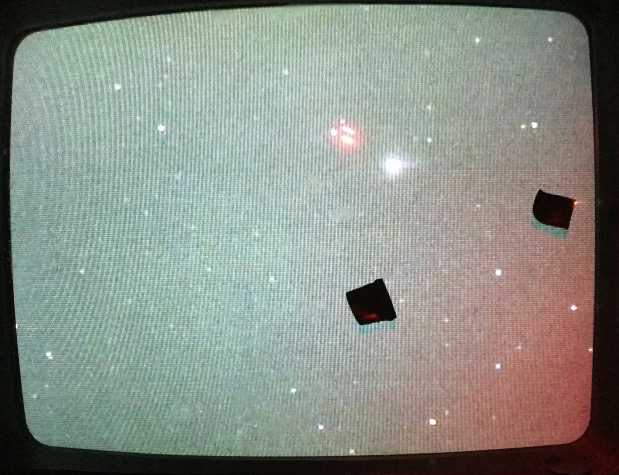
The sky value shows thick clouds early, then clear skies.
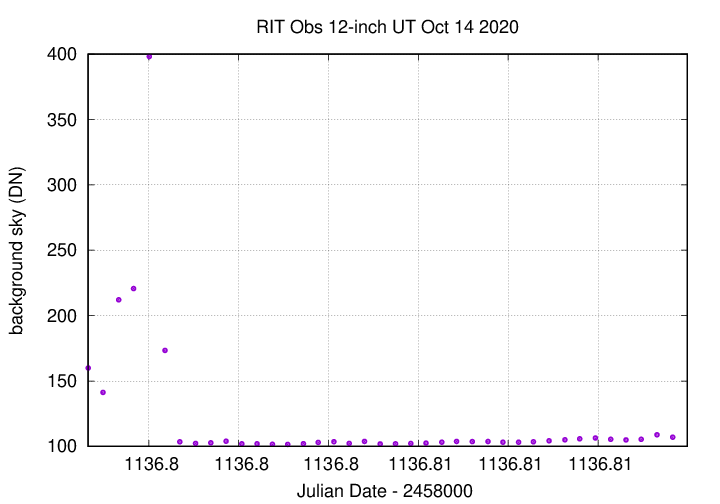
The number of objects detected.
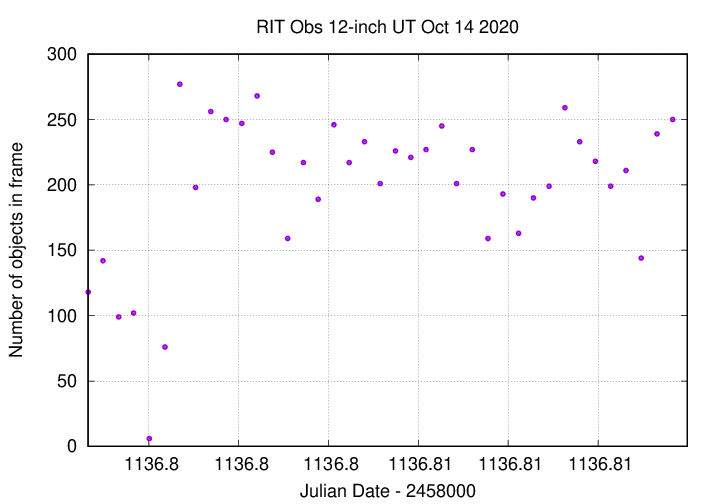

Here are the positions I've measured so far. Note the clear motion to the south-east (lower-left).
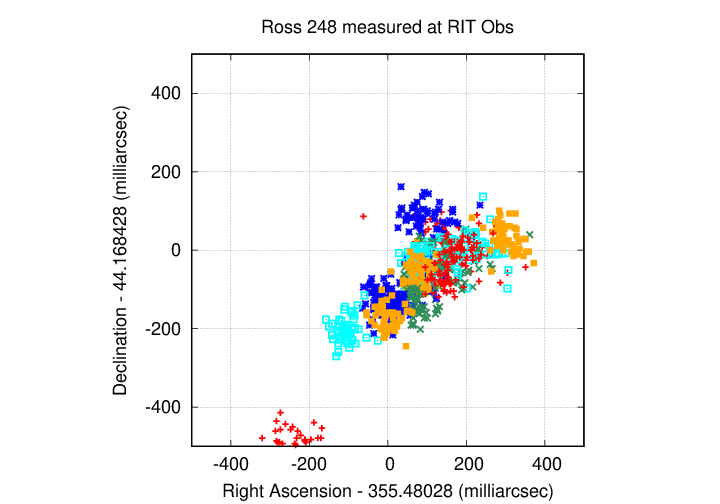
Like Ross 248, GX And is a nearby (binary) star which is the target of a parallax project in the coming year. One of the two components is bright -- about mag V = 8 -- so one must use short exposures to prevent it from saturating the detector. That may mean that this system isn't as easy to measure as Ross 248 or some others.
The object is currently close to this position:
RA = 00:18:28.4 Dec = +44:01:31 (J2000)
but it does have a very high proper motion.
A chart of the field is shown below. The size of the chart is about 41 x 27 arcminutes. The noisy area at right (West) is the shadow of the guider's pickoff mirror.
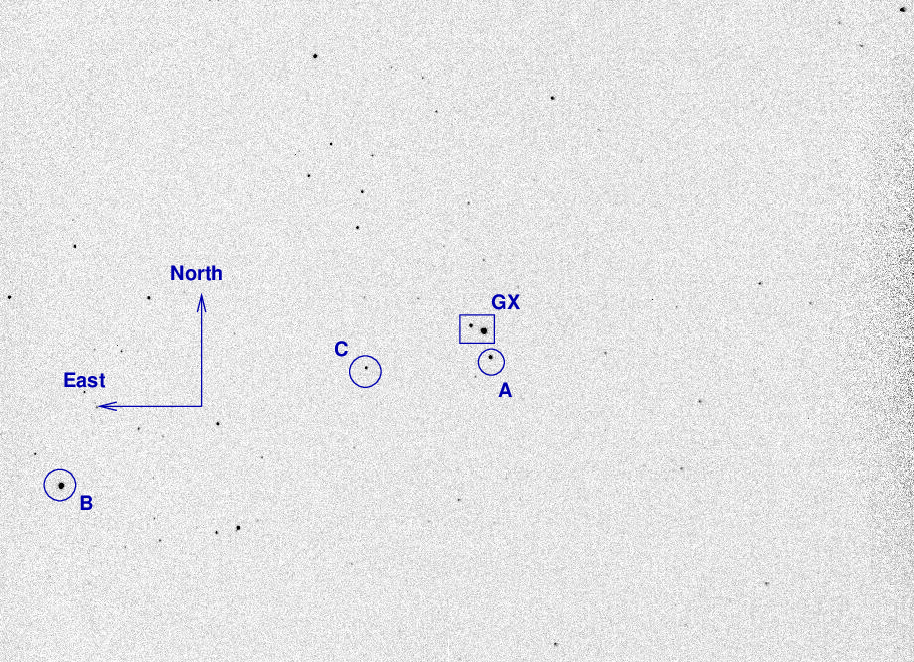
The two components of the GX And binary sit inside the box. I've marked the location of several comparison stars as well.
star UCAC4 B V r ----------------------------------------------------------- A 671-001473 9.939 9.790 B 670-001639 9.413 8.472 C 671-001509 12.712 11.421 11.001 -----------------------------------------------------------
I took a photo of the finder TV's screen when pointing to GX And; this could be a useful reference for the future:
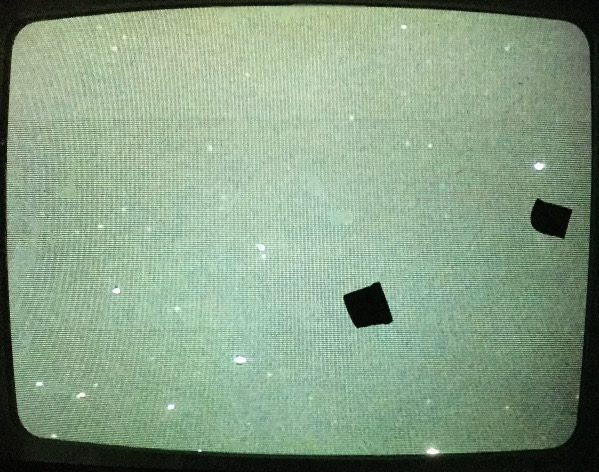
I took a total of 112 exposures of the field in R-band, using exposure times of 5 seconds.
Using the same techniques as described for earlier nights, I matched detected stellar positions to the Gaia DR2 catalog.
The target is clearly moving in the positive RA and Dec directions, as we would expect from its known (large) proper motion.
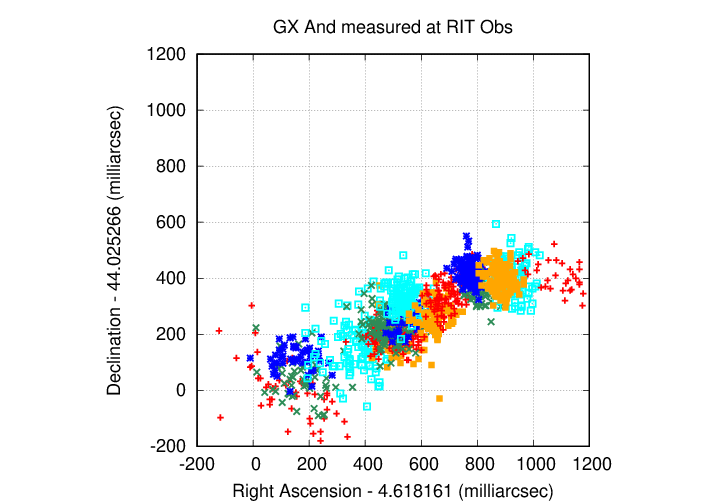
Last modified 10/16/2020 by MWR.